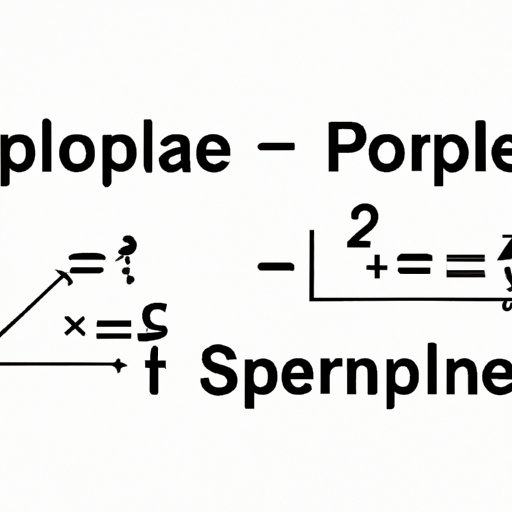
I. Introduction
If you are taking a geometry or algebra class, you may have heard about slope. Slope is a measure of how steep a line is, and it is an important concept in mathematics. Knowing how to find slope from two points is essential for solving various mathematical problems. The purpose of this article is to provide a comprehensive guide on how to find slope from two points, its real-world applications, practice problems, common mistakes, and visual aids to facilitate the understanding of the topic.
II. Formula for finding the slope of a line from two points
In order to calculate the slope of a line from two points, we use the formula:
m=(y2-y1)/(x2-x1)
Where x1 and y1 are the coordinates of the first point, and x2 and y2 are the coordinates of the second point.
Here is a step-by-step guide on how to find slope:
- Identify the coordinates of the two points.
- Substitute the values into the formula.
- Simplify the expression.
Let’s take an example:
Find the slope of the line that passes through the points (2,5) and (4,9).
Using the formula:
m=(9-5)/(4-2)
m=4/2
m=2
Therefore, the slope of the line is 2.
III. Comparing and contrasting different methods for finding slope
While the formula for finding slope from two points is the most common method, there are other ways to calculate slope. Two other popular methods include using the slope-intercept formula and using the point-slope formula.
The slope-intercept formula is useful when you know the slope and intercept of a line. The formula is:
y=mx+b
Where m is the slope and b is the y-intercept.
The point-slope formula is useful when you know the slope of a line and one point on the line. The formula is:
y-y1=m(x-x1)
Where m is the slope and (x1,y1) is the point on the line.
Each method has its advantages and disadvantages. For instance, using the slope-intercept formula is useful when you know both the slope and y-intercept of a line. The point-slope formula is useful when you only know the slope of a line and one point. However, the formula for finding slope from two points is the most versatile and can be used in a range of situations.
Let’s take an example:
Find the slope, y-intercept, and equation of the line that passes through the point (1,-2) and has a slope of 3.
Using the point-slope formula, we get:
y-(-2)=3(x-1)
y=3x-1
Therefore, the slope is 3, the y-intercept is -1, and the equation of the line is y=3x-1.
IV. Real-world applications of slope
Slope has many real-world applications. For example, stock analysts may use slope to analyze trends in stock prices. Civil engineers may use slope to determine the incline of a hiking trail or road. Astronomers may use slope to study the orbit of celestial bodies. Knowing how to calculate slope can be a valuable skill in many industries.
Let’s take a specific example:
An analyst is studying the performance of a company’s stock. They have data on the stock value for each day over the past month. The analyst wants to know if the stock value is trending up or down. They can use the slope formula to find out.
If the stock value is rising, the slope will be positive. If the stock value is falling, the slope will be negative. A slope of zero indicates that the stock value is not changing over time.
V. Practice problems for readers
Here are some practice problems for readers to try:
- Find the slope of the line that passes through the points (3,-2) and (5,6).
- Find the equation of the line that passes through the point (-1,4) and has a slope of -2.
- Find the slope of the line that passes through the points (2,3) and (-1,5).
Solutions:
- Using the formula:
m=(6-(-2))/(5-3) = 4 - Using the point-slope formula:
y-4=-2(x-(-1))
Simplifying:
y=-2x+2 - Using the formula:
m=(5-3)/(-1-2) = -2/3
VI. Common mistakes and how to avoid them
One common mistake when finding slope is mixing up the order of the coordinates. Remember to subtract the y-coordinates first, followed by the x-coordinates, when using the formula. Another mistake is dividing by zero. If the denominator of the slope formula is zero, the slope is undefined. It is also important to double-check your calculations to avoid making arithmetic errors.
To avoid these errors, take your time and check your work carefully. It can help to write out all the steps and plug in the numbers one at a time. Use a calculator when necessary and don’t rush through the calculations.
VII. Visuals to demonstrate slope
Visual aids can make understanding slope easier. For example, a graph can be used to show the slope of a line. On a graph, slope is represented by the steepness of the line. A steeper line has a larger slope than a flatter line. Slope can also be shown using a triangle. The triangle represents the rise and run of the line. The rise is the change in y-coordinates, and the run is the change in x-coordinates. The slope is then found by dividing the rise by the run.
VIII. Conclusion
Knowing how to find slope from two points is an essential skill in mathematics and has many real-world applications. In this article, we covered the formula for finding slope, compared different methods for finding slope, discussed real-world applications, provided practice problems, and explained common mistakes to avoid. We also demonstrated visual aids to facilitate understanding. By following this guide, you should be able to solve problems involving slope with confidence.





